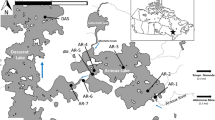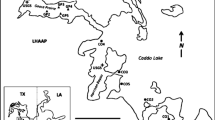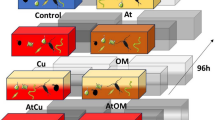Abstract
Macroinvertebrate community responses to copper (Cu) in laboratory streams receiving dechlorinated tap water and field streams receiving natural river water were compared. Since both tap water and natural river water were taken from the same source in these experiments, several of the important water quality parameters known to influence heavy metal toxicity were similar. Despite the fact that field streams were initially dominated by metal-sensitive Ephemeroptera, effects of Cu were greater in the laboratory. After 10 days of exposure to Cu (11.3 (μg/L), macroinvertebrate abundance was reduced by 75% in laboratory streams compared to 44% in field streams. In the field, the number of taxa was reduced by 10% in treated streams compared to 56% in the laboratory.
The response of dominant taxa to Cu exposure was also greater in the laboratory. In the field, abundance of metaltolerant caddisflies (Hydropsychidae:Trichoptera) was similar in control and treated streams (11.3 μg/L). These organisms were reduced by 71% in laboratory streams at similar Cu levels.
The greater impact of Cu observed in laboratory streams may have resulted from the inability of certain taxa to acclimate to laboratory conditions. The usefulness of community-level toxicity tests in the laboratory may be limited due to the overestimation of metal toxicity. We recommend that future experiments be conducted in field mesocosms receiving water directly from the system under investigation.
Similar content being viewed by others
References
Braginskiy LP, Shcherban EP (1978) Acute toxicity of heavy metals to aquatic invertebrates at different temperatures. Hydrobiol J 14:78–82
Bryant V, McLusky DS, Roddie K, Newberry DM (1984) Effect of temperature and salinity on the toxicity of chromium to three estuarine invertebrates (Corophium volutator, Macoma balthica, Nereis diversicolor). Mar Ecol Prog Ser 20:137–149
Cairns J Jr (1986) What is meant by validation of predictions based on laboratory toxicity tests? Hydrobiologia 137:271–278
Chadwick JW, Canton SP, Dent RL (1986) Recovery of benthic invertebrate communities in Silver Bow Creek, Montana, following improved metal mine wastewater treatment. Water Air Soil Pollut 28:427–438
Chapman GA (1983) Do organisms in laboratory toxicity tests respond like organisms in nature? In: Bishop WE, Cardwell RD, Heidolph BB (eds) Aquatic Toxicology and Hazard Assessment: Sixth Symposium, ASTM STP 802, American Society for Testing and Materials, Philadelphia PA, pp 315–327
Clements WH, Cherry DS, Cairns J Jr (1988a) Structural alterations in aquatic insect communities exposed to copper in laboratory streams. Environ Toxicol Chem 7:715–722
— (1988b) The impact of heavy metals on aquatic insect communities in streams: A comparison of observational and experimental results. Can J Fish Aquat Sci 45:2017–2025
Clements WH, Farris JL, Cherry DS, Cairns J Jr (1989a) The influence of water quality on macroinvertebrate community responses to copper in outdoor experimental streams. Aquat Toxicol 14:249–262
Clements WH, Van Hassel JH, Cherry DS, Cairns J Jr (1989b) Colonization, variability, and application of substratum-filled trays for biomonitoring benthic communities. Hydrobiologia 173:45–53
Hodson PV, Borgmann U, Shear H (1979) Toxicity of copper to aquatic biota. In: Nriagu JO (ed) Copper in the Environment, II: Health Effects. John Wiley & Sons, New York, pp 307–372
Jackim E, Morrison G, Steele, G (1977) Effects of environmental factors on radiocadmium uptake by four species of marine bivalves. Mar Biol 40:303–308
Livingston RJ (1988) Field verification of multispecies microcosms of marine macroinvertebrates. In: Adams WJ, Chapman GA, Landis WG (eds) Aquatic Toxicology and Hazard assessment: 10th Volume, ASTM STP 971, American Society for Testing and Materials, Philadelphia, PA pp 369–383
Livingston RJ, Meeter DA (1985) Correspondence of laboratory and field results: What are the criteria for verification? In: Cairns J Jr (ed) Multispecies Toxicity Testing. Pergamon Press, New York, pp 76–88
Miller TG, Mackay WC (1980) The effects of hardness, alkalinity, and pH of test water on the toxicity of copper to rainbow trout (Salmo gairdneri). Water Res 14:129–133
Pascoe D, Evans SA, Woodworth J (1986) Heavy metal toxicity to fish and the influence of water hardness. Arch Environ Contain Toxicol 15:481–487
SAS Institute (1982) SAS Users Guide: Statistics. SAS Institute, Inc, Cary, NC
Surber EW (1959)Cricotopus bicinctus, a midgefly resistant to electroplating wastes. Trans Am Fish Soc 89:111–116
United States Environmental Protection Agency (1983) Methods For Chemical Analysis of Water and Wastes. Environmental Monitoring and Support Laboratory, Cincinnati, OH
Van Hassel JH, Gaulke AE (1986) Site-specific water quality criteria from in-steam monitoring data. Environ Toxicol Chem 5:417–426
Winner RW, Gauss JD (1986) Relationship between chronic toxicity and bioaccumulation of copper, cadmium, and zinc as affected by water hardness and humic acid. Aquat Toxicol 8:149–161
Winner RW, Scott Van Dyke J, Caris N, Farrell MP (1975) Response of macroinvertebrate fauna to a copper gradient in an experimentally-polluted stream. Verb Int Verein Limnol 19:2121–2127
Winner RW, Boesel MW, Farrell MP (1980) Insect community structure as an index of heavy-metal pollution in lotic ecosystems. Can J Fish Aquat Sci 37:647–655
Author information
Authors and Affiliations
Rights and permissions
About this article
Cite this article
Clements, W.H., Cherry, D.S. & Cairns, J. Macroinvertebrate community responses to copper in laboratory and field experimental streams. Arch. Environ. Contam. Toxicol. 19, 361–365 (1990). https://doi.org/10.1007/BF01054979
Received:
Revised:
Issue Date:
DOI: https://doi.org/10.1007/BF01054979




